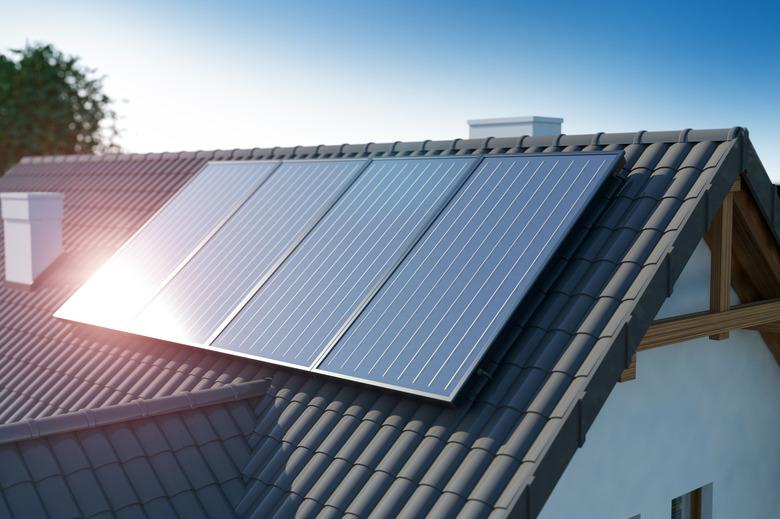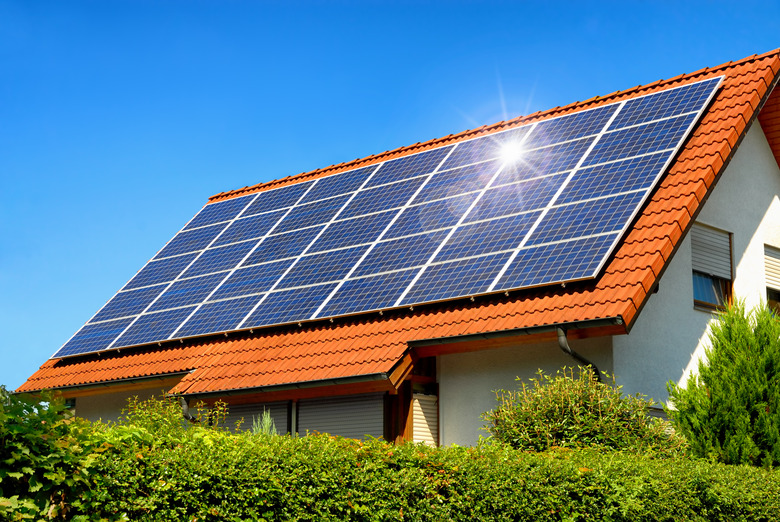How To Calculate The Cost Of A Solar Roof
We may receive a commission on purchases made from links.
The idea of solar roofs or solar shingles mixes both function and beauty. As you begin looking into the various options and manufacturers, you may discover that pricing for solar roofing is complicated and inconsistent. Different manufacturers and installers use different methods for calculating cost, and pricing can also vary from one region to another.
Solar roofs or solar shingles, technically called "BIPV" (building-integrated photovoltaic shingles), are solar panels that mimic the function and look of conventional roofing materials while generating solar energy. Studies backed by the Department of Energy have shown that solar roofing, such as solar shingles, can increase the value of your home by $15,000 or more.
Government and utility company incentives have really helped close the gap on affordability and yet add to the confusion for homeowners at the same time. The whole subject is an information overload. Gathering what you need to know and understanding what it means is the right recipe for success in figuring out the cost and return on investment of your solar roof system.
Efficiency of Solar Roof Brands
Efficiency of Solar Roof Brands
Determining whether the extra cost to install a solar roof over traditional solar panels is the question. Solar cell efficiency is how much sunlight is converted to usable energy. Most traditional panels have an efficiency of anywhere from 15 to almost 22 percent of usable solar energy. Traditional solar panels cost an average of $2.70 per watt, and a solar roof (depending on style and brand) will cost anywhere from $4.50 to $15 per watt. Much like traditional solar panels, efficiency depends on brand and style of BIPV along with the pitch or angle of your roof construction. Upon installation, traditional solar panels can be angled to better absorb the sun's energy, whereas a solar roof is subject to the roof design.
The brand Luma boasts a 22.1 percent efficiency with its solar shingles. Luma edge to edge can cost around $38 per square foot and $4.50 per watt. Other BIPV product manufacturers, like CertainTeed, have a low efficiency — Apollo II solar shingles are at 15.4 percent and cost $17.25 to $22 per square foot or $6.40 to $8 per watt. The Apollo II solar roof tiles are at 16 percent efficiency and cost $20.88 to $27.37 per square foot and $7.65 to $10 per watt.
Suntegra's low-profile roof material goes anywhere from 15.9 to 17.2 percent efficiency, and its solar tiles are at 13.9 to 15.1 percent with shingle prices ranging from $15.52 to $17.40 per square foot and $5.70 to $6.40 per watt. Suntegra's solar tiles cost $16.80 to $21.30 per square foot and $6.16 to $7.81 per watt.
Where Does Tesla Fit In?
Where Does Tesla Fit In?
Nothing is mentioned about Elon Musk's Tesla solar roof system efficiency. This is because a comparable efficiency is currently unavailable. There is, however, information regarding wattage output. Tesla has just redesigned its solar tiles and has increased its wattage from 58.5 watts per tile to 71.67 watts. This output is comparable to other brands of a lesser price. A Tesla solar roof will cost $32 to $42 per square foot and $11.07 to $15.40 per watt. The production is slow, and the wait might be too long to take advantage of any current incentives.
Return on Investment
Return on Investment
If you are already in need of a new roof, then a solar roof may be a solid choice for a roof replacement. The return on investment, according to the Department of Energy, has the potential of 71.6 percent for just the new roof, but don't forget about the savings on your electric bill by going solar.
Sizing the Solar Roof to Calculate the Cost
Sizing the Solar Roof to Calculate the Cost
The cost of building-integrated building-integrated photovoltaics is primarily done on a case by case basis. Your personal energy consumption will be different from your neighbors. Even though the houses may be exactly the same, everyone's needs are different.
The cost is also determined by your specific location. Someone in Texas may have different solar installation costs than someone in Vermont due to the cost of labor and the available sunlight per day. The more sunlight, the less photovoltaic surface area is needed to suit your personal needs. In addition to this is the azimuth (orientation to the sun), which adds to the effectiveness of the sun's power production.
To calculate your electricity usage and cost, you just need to look at your electric bill. A kilowatt-hour (kWh) is a measurement of electricity usage over time. One kilowatt hour is equal to 1,000 watts used per hour. Most residential electrical service is based on the cost per kWh. Your household usage and the price you pay per kWh should be specified on your utility bill.
More Calculating Factors
More Calculating Factors
Your roof's pitch has an effect on solar production but also adds to the cost of labor. The steeper the pitch and the higher the roof, the more equipment and safety precautions are needed. Some pitches are very dangerous for the installation crew.
Roofers use the term "square," which is actually 100 square feet, or a 10 x 10 foot area. The hard part is knowing how much usable area you have. The less usable area, the less potential use of your solar roof. If your roof has a lot of hips and valleys, then those areas are unusable with a solar roof.
One serious cost to consider when calculating is the type of system you want. One system that merely feeds back into the grid and does not store power will not give you the return on investment you may desire. Something like Tesla's Powerwall stores any excess power produced. It adds quite a bit to the system cost but has more return on investment, much like a home generator may give. The cost of one single Powerwall is $6,500 plus installation costs of $4,000. This Powerwall gives you 13.5 kWh of stored energy. Each additional Powerwall is $6,500 with no additional installation cost. It is always a good idea to get a professional opinion of your specific needs to keep from either oversizing or undersizing your solar power needs.
Solar Energy Incentives
Solar Energy Incentives
The federal tax incentive for systems installed between 2020 and 2022 is 26 percent of the system cost. It goes down to 22 percent in 2023. Your state and local municipality may have something to give as well. There are specific websites that help you figure out your potential incentives. Navigating anything that gives you money back is never easy, but the solar roof professionals know how to navigate the incentives to help entice the sale.
References
- Modernize Home Services: Solar Roof Shingles
- EnergySage: How Much Does a Solar Panel Installation Cost?
- EnergySage: Tesla Solar Roof: The Complete Review
- CleanTechnica: Meet The Men Who Put Solar Shingles On The Roof
- Sunpower: How Many Solar Panels Do You Need: Panel Size and Output Factors
- Forbes Advisor: Solar Tax Credit 2021 By State: What You Need To Know
- CertainTeed: Apollo Tile II
- Energy.gov: Solar Homes Sell for a Premium
- Roofing Calculator: BIPV Solar Shingles Cost: SunTegra, CertainTeed Appolo, Tesla Solar Roof
- Current Results: Average Annual Sunshine by State

